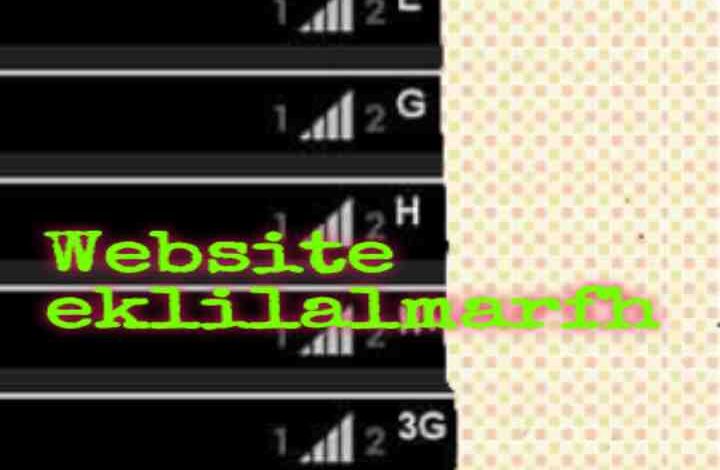Secrets of Internet codes (+E, H, G, H) in smart phones
Secrets of Internet codes (+E, H, G, H) in smart phones

Secrets of Internet codes (+E, H, G, H) in smart phones.
Many of us notice the presence of these signs (+E, H, G, H) when we use a mobile phone. What do these signs symbolize? And why does the speed of the Internet vary according to these symbols?
The emergence of the first generation network in smart phones
The beginning of the use of mobile phone networks in its current form was in Tokyo, Japan in 1979 AD, by the company “NTT”. This is the first generation of mobile networks.
Within five years the company expanded its reach, to cover the whole of Japan. Thus, Japan remains the first country to be covered by a complete telephone network.
After that, the second generation of networks appeared in the year 1990 AD. This was the first development of mobile phone networks, but what was the development in this generation?
The development in this generation was to replace the signals that are sent between the telephone and the network towers to a “digital” signal. It was even “analog” in the first generation.
Information about the second generation networks in smart phones
The second generation has appeared in the form of two systems, the first is called “Global system for mobile communications”, and its abbreviation (GSM). The second is called “Code Division Multiple Access”, otherwise known as (CDMA).
What is the difference between (GSM) and (CDMA) systems
Therefore, we explain the main difference between them, which is that the (GSM) system uses (TDMA) and (FDMA) technologies. So that the network tower can deal with more than one phone, within its range, without any interference between them.
What are (TDMA) and (FDMA) technologies in smart phones
Before that, the term (TDMA) technology is an acronym for “Time division multiple access”. Therefore, each frequency is divided into time groups called (Time slot), and each device uses the (Time Slot) to send and receive with it. For example, there is a specific number of frequencies for use, and in order to provide the number of devices for each tower, what do we do? We divide the time of one frequency into a certain number of parts – each device is assigned a part to be transmitted with. Thus, a single frequency deals with more than one device, instead of a single device as it was in the first generation.
Now we explain the technology (FDMA), which is an acronym for «Frequency division multiple access». Then the (FDMA) technology is the same idea as the (TDMA) technology, but here the entire frequency is used, but for a limited time, and so on for the next phone.
What is (CDMA) system in smart phones
We come to the (CDMA) system, which uses another protocol and bears the same name – the name of the system is taken from the protocol – but what does this system do?
In this protocol, a telephone can transmit on the entire frequency and all the time. but how
There is a technology called spread-spectrum, in which information is distributed over the entire spectrum and each device takes a code in order to differentiate between them and not to conflict between them.
Moreover, the (CDMA) system is better than the (GSM) system in terms of security and confidentiality. However, the problem with the CDMA system is that it requires high power, which affects battery life and reduces network tower coverage.
When was the first text message (SMS) sent on a smartphone
The first text message (SMS) was sent in 1992 AD, as it was only available for (GSM) systems at first, until it was applied to the rest of the systems.
Then, in 1998, the first multimedia file was uploaded, and it was a phone ringtone.
What is the GPRS system in smart phones
The GPRS system known as (2.5G) appeared, which is considered a breakthrough in the second generation, and it is the path that connected the second generation to the third generation using (packet-switched domain) technology. Which means collecting all the data that will be sent in one package, and this package is given information, through which the hardware can deliver the package to the addressee, this information is provided by “HEADER”.
What does the G symbol mean on smartphones
The letter (G) that used to appear on old phones, before the advent of the third generation (3G), indicated that the phone was using the GPRS system at this time. Where the data transfer speed reached: 56 – 114 kilobits per second.
We come to (2.75G), which is known as (EDGE), or (EGPRS), which is an acronym for “Enhanced Data Rate for GSM Evolution” and “Enhanced GPRS”.
(EDGE) technology was designed to improve the data transfer rate, it was actually applied in the year 2003 AD, and it does not require any change in the software or hardware of the (GSM) system in order to apply it.
The increase in data speed in EDGE technology is due to its use of a new modulation method called (8PSK).
What does the letter (E) mean in smartphones
The data speed is 400Kbps, and it can reach 1MB/s at the maximum rate. This is the secret of the letter (E), which appears when the Internet is slow.
In December 1998, the 3rd Generation Partnership Project (3GPP) was formed. It is a group of associations interested in communications. The aim of this group was to reach the third generation of mobile phone systems based on (GSM) technology, and is applicable globally.
The project support team is based at the European Telecommunications Standards Institute in Sophia Antipolis, France.
While at the same time, (3GPP2) technology was designed by other institutes, but they relied on their design on the (CDMA) system instead of the (GSM) system.
The emergence of the third generation in smart phones
The project of the third generation of mobile phones resulted from a new system based on the GSM system, called the Global Mobile Telecommunications System.(UMTS).
The (UMTS) system was based on “wideband code division multiple access (W-CDMA)”, and it was developed from the regular (CDMA) system.
However, the technology of the UMTS system is not like the EDGE system, because it needs modifications in the stations and the frequencies used.
The data transfer speed of the UMTS system is up to 384 Kbit/s for its first version.
At the end of 2007, the number of third-generation users reached 295 million. This was followed by the emergence of the “High-Speed Packet Access (HSPA)” protocol, which is equivalent to (3.5G), which enables the UMTS system to increase the transmission rate to reach high rates. Where the download rate reaches 14 Mbps, and the upload rate reaches 5.76 Mbps.
What does the symbol or letter (H) appear on smartphones mean
HSPA protocol consists of two systems that work together, a download system which is
High Speed Downlink Packet Access (HSDPA)
And a lifting system, which is “High Speed Uplink Packet Access (HSUPA)”. It was taken into consideration that the download speed is greater than the upload speed in the design of the system.
Thus, when the internet signal is (H), the internet is in perfect condition.
What does the symbol or letter (H+) mean on smartphones
It is noteworthy that in 2008 the (HSPA+) protocol appeared, or “Evolved High-Speed Packet Access”, which is a development of the (HSPA) protocol.
The HSPA+ protocol reaches impressive transfer rates, with download speeds of up to 168 Mbps and upload speeds of up to 22 Mbps.
These speeds represent the highest theoretical speed of the system, but sometimes these speeds are less than the theoretical speed, and this is the secret of the Internet speed when the letter (H+) is used.
Finally, in 2009, the Long-Term Evolution project, known as the fourth generation, appeared. But in fact, it is only the generation before the fourth, or an extension of the third generation (3.9G), but it was marketed commercially as the fourth generation.
Watch also: Watch Auphghwp’s method for detecting gold with
The (Long-Term Evolution) project has download rates of up to 300 Mbps for download and 75 Mbps for upload.
The emergence of 4G technology in smart phones
When the fourth generation 4G technology appeared in Japan, specifically in 2010, and it was characterized by a high speed, then it appeared in all European countries in the history of 2013. It spread to all countries of the world in 2016, and the speed of the fourth generation 4G is estimated at about 32.5 MB / s. It may reach 40 MB / sec. The upload speed in the fourth generation is between 5-6 megabytes/second, and may reach up to 15 megabytes/second.
The speed of the fifth generation 5G in smart phones
So far, the speed of the fifth generation is the best, and the fastest among the networks, as the fifth generation is characterized by speeds that may reach 20 Gbps as a maximum speed, and for the average, the speed will reach more than 100 Mbps.
Comparing the speed between the fourth generation and the fifth generation in smart phones
The network capacity in the fifth generation is greater, for example, the number of devices connected to the same tower will be much greater. The delay time is less than the fourth generation, and the frequencies used in the fifth generation are better than those used in the fourth generation. When the fourth generation was designed, the primary goal was to improve the speed of those used in the fourth generation, or the fifth generation. It was designed to be faster, to support time-critical applications, and not to accept any delays. Such as controlling devices remotely, such as VR virtual reality applications, and AR augmented reality. The fifth generation is also designed to be more effective in Internet of Things applications.



